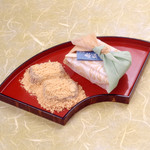
赤坂青野 本店
Akasakaaono ◆ あかさかあおの
3.67
Akasaka
「Japanese Sweets」
--
--
Opening hours: [Monday-Friday] 9:00-18:00 [Saturday] 9:00-17:00
Rest time: Sunday & Holidays
東京都港区赤坂7-11-9
Photos
(20)
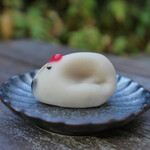
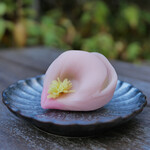
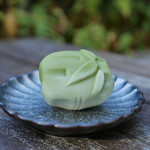

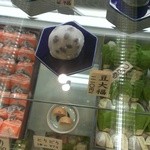

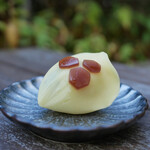
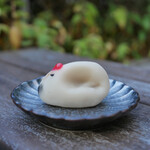

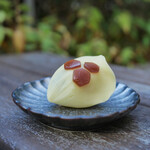
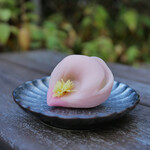
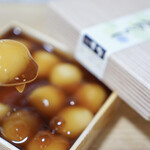
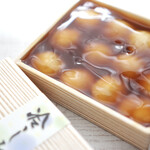

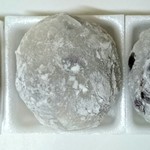

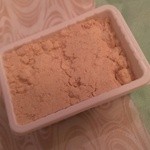
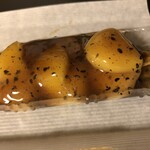
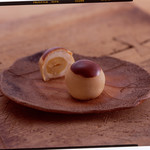

Details
Reservation Info
Reservations accepted Some items are only available by reservation.
Children
Children (breastfeeding children, children not attending school, elementary school children)
Payment Method
Credit cards accepted
(JCB, AMEX, VISA, Master, Diners)
Electronic money accepted (transportation system electronic money (Suica, etc.), Rakuten Edy, iD)
QR code payment accepted
(QR code payment available (PayPay)
Number of Seats
2 seats
Private Dining Rooms
None
Smoking and Non-Smoking
No smoking at the table
Parking
None
Comments
(21)
ヤッグ
4.50
Visited around 13:00 on Saturday. A top-ranked restaurant in the TOP5000. Fortunately, it was not crowded, so I was able to enter right away. The interior of the restaurant is very clean. I started looking at the menu and choosing what to buy. I planned to buy the signature dish "Akasaka Mochi". I asked the staff for recommendations for other menu items. The staff kindly explained the menu to me. It was very easy to talk to them. I chose the following items: - Akasaka Mochi (5 pieces) for 1,100 yen - Yaki Monburan (320 yen each, 5 pieces) for 1,600 yen - Hitotsubu (250 yen each, 5 pieces) for 1,250 yen - Strawberry Daifuku for 300 yen - Bean Daifuku for 250 yen - Sakura Mochi with sweet bean paste (230 yen each, 2 pieces) for 460 yen - Kansha no Ki Mochi (complimentary) Total: 4,960 yen (including tax, total 5,356 yen). I ate them at night after returning home. My family had already finished eating and they were praising the "Yaki Monburan" and the "Kansha no Ki Mochi". - Akasaka Mochi It's like a Shingen Mochi, but the way of eating is different. You take the mochi out on the paper it's wrapped in, dip it in the kinako powder, and eat it. It lived up to its reputation as a signature dish. There was plenty of kinako powder on it. The mochi was very soft. - Yaki Monburan This is almost like a cake. The chestnut paste was especially delicious! The chestnut was soft and had a unique texture. The expiration date is 20 days, so it's good for storing! It was just delicious! - Hitotsubu This is a chestnut manju. The red bean paste is a bit dry, but the chestnut was moist and had a perfect balance. - Strawberry Daifuku It's a type of fresh confectionery, recommended by the staff. My family ate this, and they said the acidity of the strawberry and the sweetness of the red bean paste matched well and was delicious. - Bean Daifuku Also recommended by the staff. The beans added a nice texture and complemented the sweetness of the red bean paste. The red bean paste was delicious. - Sakura Mochi with sweet bean paste I was personally curious about this and bought it. The saltiness was mild, the red bean paste was just sweet enough, and the subtle sakura flavor was delicious. - Kansha no Ki Mochi A mochi made with black sugar. It's small in size, but it's simple and incredibly delicious! The mochi was chewy! It was a restaurant that made me want to go back again. Thank you for the meal.
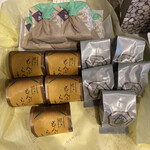
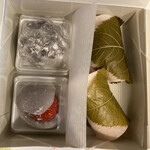
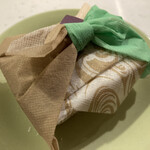

ファーピョウ
4.00
It is recommended to go from Nogizaka Station as it is a bit far from Akasaka Station, to this long-established Japanese confectionery shop. I bought Muscat Daifuku for 300 yen and the Daifuku loved by Jobs for 250 yen here and brought them back. I enjoyed them at the office.
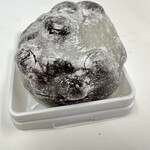
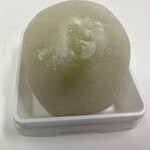
ジョルノ承太郎
3.80
About a 15-minute walk from Roppongi Station on the Hibiya Line, this place has a wide variety of high-quality offerings. The cold mitarashi is very popular and often featured on TV, but today I purchased the following two types through online reservation only. The total was 475 yen including tax:
- Akasaka Mochi (220 yen): Comes with two pieces of mochi generously covered in kinako and walnuts inside, which adds a delicious touch.
- Goma Meigetsu (220 yen): Sweet mitarashi with sesame flavor generously coated, giving a chewy texture. The small chestnuts are a nice addition. Overall, I enjoyed them very much until the end. Thank you for the delicious meal.
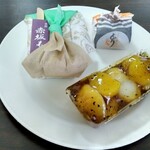
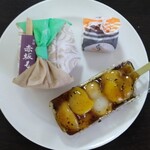
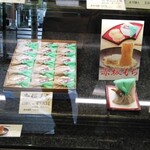
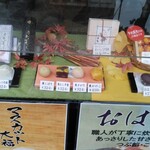
seven357
4.00
Located between Akasaka and Nogizaka, this place is famous for its reserved chilled mitarashi dango. However, since reservations are already full, you can choose what you want to eat on the spot. The sesame moon, grass dango, and Akasaka mochi are each 220 yen. The dango has a shelf life only for the day. They are incredibly soft and smooth. The sesame moon has black sesame in the mitarashi, so you can also enjoy its deliciousness. The grass dango has shiny red bean paste on top. It's not too sweet, and has a strong aroma of mugwort. The Akasaka mochi is covered in plenty of kinako, and the soft mochi disappears in no time. It's a unique treat different from traditional warabimochi. The service and attention to detail show that it is a well-established famous shop. I would like to visit again.
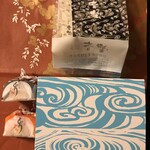


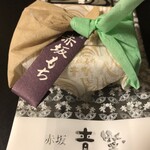
chengdu4000
3.00
There are several stores in the Akasaka area that have been selected as top 100 stores, but I wonder if it's because it's the main store. The reason for selection is because I tried the red bean daifuku and it was delicious. There is no doubt that the Japanese sweets are delicious. However, I don't know if there is a difference between the stores selected as top 100 and those that are not. Seriously, I think the genre of top 100 stores can give you a sense of emptiness by visiting them more than ethnic top 100 stores.
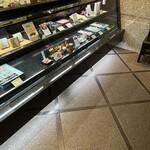
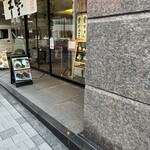
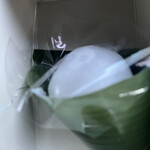
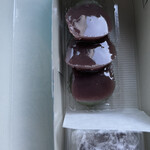
UK0123
3.80
I entered this shop for the first time on Friday around noon. I pass by here often, but I never noticed it before. There was no wait. I bought a Akasaka Mochi for 237 yen and enjoyed it in a nearby park. When I opened the bag, I found a refined mochi with a moderate amount of sugar and plenty of kinako powder, and it was delicious! If I had known it was this good and convenient to buy, I would have visited sooner. Thank you for the meal! I will definitely come back.
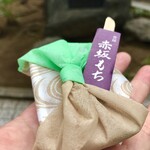

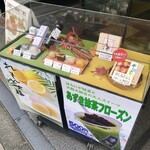
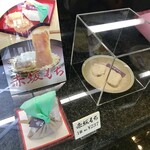
どくだみちゃん
3.70
I have always loved the seasonal limited edition "mitarashi dango" that I received from a friend. I decided to buy some for myself this time. You can only reserve them online through the store's website, with a limit of 3 boxes per person. I made a reservation a month in advance! There are several stores around Akasaka, but I went to the main store this time. It's a street shop on the way from Akasaka to Nogizaka. They also sell other tempting treats like limited edition taiyaki, warabi mochi, and Mizu Daifuku. I provided my reservation number and successfully got my order. They also gave me paper bags for the items. I brought them home and enjoyed them chilled. Even when chilled, the mochi doesn't get hard, which is amazing about this mitarashi dango. The fluffy and chewy dango coated with plenty of mitarashi sauce is just perfect, and it's always delicious no matter how many times I have it! It's a treat that everyone can enjoy, and at a reasonable price of 972 yen per box, it's easy to give as a gift or enjoy for yourself. It's like a summer tradition snack. They are available for sale until the end of October, but reservations are already closed. Looking forward to next year!
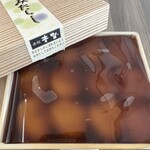

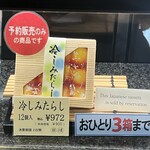
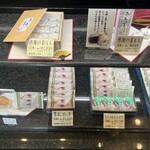
美食家 K
3.40
"Akasaka Aono Main Store" is a shop in Akasaka that has been awarded as one of the top 100 shops in the Japanese sweets category on Tabelog for the 2023 fiscal year. Today, I visited the main store. I had heard a lot about their chilled mitarashi dango being featured on TV and wanted to try it, but it was only available by reservation. The staff's customer service was excellent. Their famous sesame mangetsu consists of a chewy dumpling topped with chestnut and a sweet and savory sauce with ground sesame. The flavor is addictively sweet and salty. The bean daifuku was also delicious with a moderate level of sweetness. It was really tasty. Thank you for the meal. #AkasakaAono #AkasakaGourmet #AkasakaLunch #AkasakaSweets #Sweets #WantToConnectWithGourmetLovers #GourmetInstagram #GourmetMemo #WantToConnectWithGourmetPeople #FoodPornGram #FoodPornLover #FoodStagram #FoodStagrammer #FoodPornism #GourmetTravel #DeliciousIsHappiness #LookingForGourmetFriends #FoodieClub #FoodieGirls #FoodieBoys #WantToConnectWithFoodies #KantoGourmet #FoodReviewGram #GourmetReport #GourmetWriter #FoodWriter #BGradeGourmetInformation #TokyoGourmet"
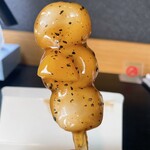
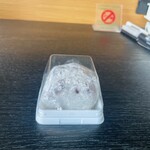
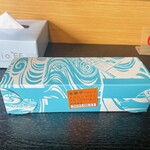
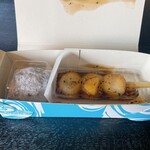
あるぱかーん
3.90
When it comes to traditional Japanese sweets in Akasaka, the first place that comes to mind is Aono. In addition to the main store in Akasaka, there are four branch stores nearby: Akasaka Mitsuke, Akasaka Sacas, Tameike, and Benkei Bridge. Although this was my first time at this particular store, I have visited a few times before. They offer a wide variety of sweets, albeit at slightly higher prices. While all their products are appealing, the Akasaka Mochi, Goma Myogetsu, and the summer limited edition Chilled Mitarashi are especially famous. The Chilled Mitarashi is so popular that it requires advance reservation and tends to sell out quickly. It has been featured in various media outlets. Please note that without a reservation, you may not be able to purchase it. However, other items can be reserved in advance. Personally, I have tried the Akasaka Mochi and Chilled Mitarashi before, so this time I chose the Goma Myogetsu. The staff who assisted me were very kind, and their confidence in their products was evident. Their humble attitude despite being a long-established store was admirable. ▶︎Purchased item: Goma Myogetsu 237 yen - A Mitarashi dango with chestnut sweetened in the shape of a crescent moon, topped with a soy sauce sauce with ground sesame. Oh man, why didn't I buy this sooner? The soy sauce sauce, not too sweet or too spicy, is just right, with a fragrant and gentle texture thanks to the sesame. The mochi is very soft, stretchy, and smooth. It just disappears in an instant because it's so delicious! The sauce and mochi are so tasty that they're gone in a flash. As expected of Aono, it was a very delicious Mitarashi. With this quality, the price is justified. As always, where there is Akasaka, there is Aono. Thank you for the meal!

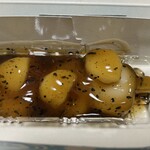
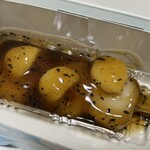
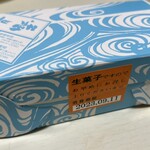
ますら王
3.50
Visited around 17:15 on a regular day. There were about 3 groups of 5 people each. Red bean mochi for 237 yen, delicious! The mochi is soft and has a crunchy texture from the walnuts. Lemon daifuku for 270 yen, more lemony than I imagined. The daifuku is soft and the red bean paste is dense.
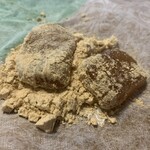
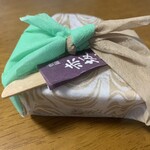
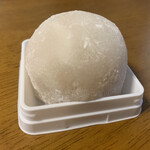
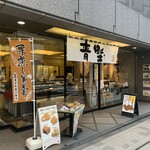
古舘 達也
4.90
Established in 1899, the renowned traditional Japanese confectionery shop "Akasaka Aono Main Store" in Akasaka offers a delicious cold mitarashi dango available only during the summer season by complete reservation. The 12-piece set is voluminous, perfect for sharing with multiple people or enjoying over multiple occasions. Typically, dango becomes hard when chilled, making cold mitarashi dango seemingly impossible. However, by using a flour base made from tapioca powder to prevent hardening, they have successfully created cold mitarashi dango. Announcements for reservation availability are made through the official Instagram account of Akasaka Aono, so make sure to follow @aonoakasaka if you're interested! The famous Steve Jobs was said to have enjoyed Aono's manju, and aside from the cold mitarashi dango, their other traditional Japanese sweets are of high quality and very delicious. #AkasakaAono #ColdMitarashiDango #MitarashiDango #JapaneseSweets #TraditionalJapaneseSweets #JapaneseConfectioner #JapaneseSweetsLover #Dango #Mochi #NamaGashi #GomaNagetsu #WarabiMochi #Manju #SteamedBun #Daifuku #SweetBeanPaste #Taiyaki #AzukiBean #RedBean #Akasaka #AkasakaGourmet #AkasakaCafe #AkasakaMitsuke #Toranomon #SummerVacation #SteveJobs #Japan
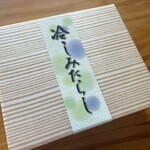
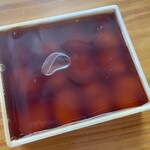
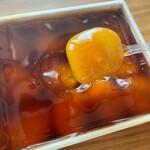
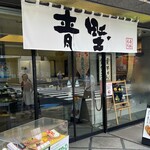
macaron0227
3.70
In Akasaka, there is the Aono Main Store, which was selected for the "Top 100 Traditional Japanese Sweets Shops 2023" award. After visiting Flufu for pancakes, I made a reservation for Aono Main Store on the reservation start date of August 15th. On the day of the visit, I had pancakes at the Hotcake Parlor Flufu, then stopped by Akasaka Hikawa Shrine to pick up the reserved chilled Mitarashi Dango in the afternoon. When I arrived at the store at 12:40, there was one customer ahead of me and three customers behind me. When it was my turn, I provided my reservation email number and name, received the products, and made the payment. I purchased 3 chilled Mitarashi Dango (972 yen each) and a limited edition Azuki Matcha Frozen drink (500 yen), totaling 3416 yen. I enjoyed the Azuki Matcha Frozen drink inside the store, which had a rich matcha flavor with sweet red beans on top. The chilled Mitarashi Dango, which I bought 3 of, had a generous amount of Mitarashi sauce and were recommended to be kept in a cooler box if carrying around. The customer service, from reservation confirmation to product guidance, payment, and farewell, was consistently polite. The chilled Mitarashi Dango has a 2-day shelf life and contains 12 pieces in a box. It is recommended to store them in the refrigerator. The next reservation for October will be available from September 15th to 20th, and interested customers can follow the store's Instagram for easier reservation. Enjoyed the delicious treats!
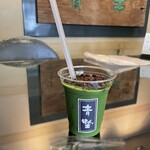
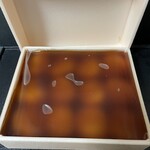
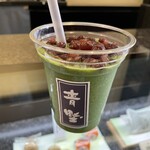

じゅみりん
3.70
I wanted to try the chilled Mitarashi (rice cake in sweet soy sauce) and kept checking the reservation screen, but the "sold out" message never disappeared. I thought it might be ending soon for this year, so maybe I'll try again next year. However, I decided to visit anyway. First, I took a break from the heat by enjoying a matcha frozen dessert. It was stated that it would end on 9/15. The dessert had a rich matcha flavor with plenty of large simmered red beans on top. I enjoyed it while sitting inside the shop. There were so many types of sweets, and I was indecisive about which ones to try. I ended up buying various sweets as gifts for my friends whom I will meet on the weekend, and my bag became quite heavy on the way back. One of the shop's signature sweets, "Kurobei," had red bean and coffee flavors. The "Coffee Kurobei" won the gold medal in the "Contest for Japanese Sweets Using Coffee" held by the National Japanese Confectionery Association in 2016. It was a unique sweet consisting of coffee castella with chopped walnuts wrapped in coffee yokan, and coated with coffee granulated sugar. The "Yakimonbran" had a large chestnut in honey and a soft chestnut paste dough. The "Tokyo Kinako" was a financiers cake with kinako (roasted soybean flour) mixed in, creating a fusion of Western and Japanese sweets. It was created as a souvenir from Tokyo. I learned from the articles in the shop that they provided guidance on Japanese sweets for the TBS drama "We Are Just Not Ourselves" and that Steve Jobs liked their manju (steamed bun) as well. With such recognition, this shop is truly one of Japan's leading traditional sweet shops.

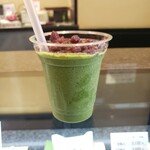
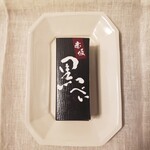
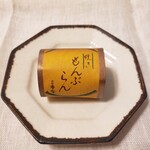
気ままな探索者
3.50
I visited around 4:15 pm on a weekday and was able to purchase smoothly. I bought the following items:
- Red bean mochi for 237 yen each: A well-balanced treat with just the right sweetness, a chewy texture, and a hint of walnut flavor.
- Lemon daifuku for 270 yen: A sweet yet refreshing treat with lemon peel in the white bean paste, perfect for summer.
I would like to visit again if I have the chance. Thank you for the delicious food!

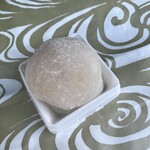
もりC
3.60
I went to Akasaka and visited Akasaka Aono Main Store. Since I didn't have much time, I bought a traditional Japanese sweet called "oyaki" that was nearby. Inside the Japanese-style packaging, there were sweets shaped like sea bream. They are baked, so they seem to last long. Inside the firm skin, there is sweet red bean paste. It's not very moist, so tea is needed, but it's a delicious traditional Japanese sweet. Next time, I would like to try their fresh sweets.
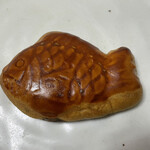
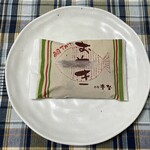
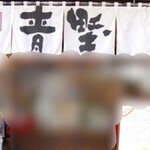
弥生ぃ(つ∀`*)
4.00
Founded in 1899, this restaurant's signature item is the "Akasaka Mochi" (originator of the small furoshiki wrapping). Popular items include the reservation-only "Hiyashi Mitarashi" and the "Goma Meigetsu" featured on TV. The Goma Meigetsu is a chestnut sweet, ground sesame, and soy sauce delicacy that is soft, sweet, and salty - simply delicious. The restaurant accepts credit card payments and is managed by the Akasaka Aono Seika Corporation. The current president is Keiki Aono. While there are many traditional Japanese confectioneries across the country, this restaurant is known as the originator of the "small furoshiki wrapping" style. Steve Jobs was a big fan of their steamed buns, as mentioned in the book "Jobs no Ryourinin." The restaurant was also involved in the production of the drama "Watashitachi wa Douka Shiteiru," where they taught the main actors how to make traditional Japanese sweets. The "Goma Meigetsu" was ranked 3rd in the annual souvenir ranking on the TV show "Tunnels' No Food, No Like King." This restaurant has many interesting stories and accolades.
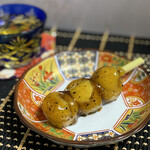
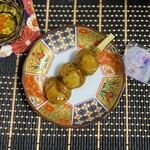
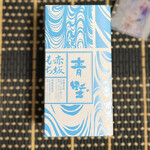
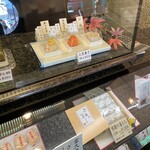
ZDM1000R
3.50
I walked all the way from Tameike-Sanno to a traditional Japanese confectionery shop in Akasaka, known for its delicious Daifuku. Inside the shop, there were various types of sweets such as baked goods, fresh sweets, seasonal limited items, and traditional Japanese confectionery. It was hard to decide what to buy, but I stuck to my initial plan. When I asked about the shelf life, I was told that the Shiratama (rice flour dumplings) were good for the day, while the Daifuku could last until the next day. The Daifuku was pleasantly sweet without being too heavy, and it paired well with bitter green tea. I wonder if it was made with Japanese sugar? The Shiratama was purchased as a gift for a model who was invited to Akasaka Ogino, and although it was said to be less sweet, the presentation was completely different.
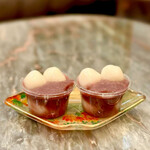
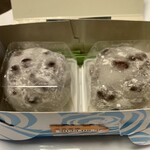
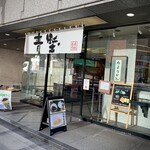
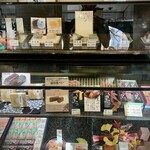
如月 来夏
3.50
This chilled mitarashi (sweet soy sauce) is famous for selling out within seconds once reservation slots are opened. It has yet to win a single battle. It is only available for purchase through reservation, with no direct sales at the storefront. It used to be available for purchase at the store, but due to its overwhelming popularity, production couldn't keep up and it became reservation-only. Alongside "Shiono," it is a staple of Akasaka's traditional sweets, known for being beloved by the likes of Steve Jobs. As an Apple enthusiast, it's almost like a sacred place. Located on a grand street descending from Akasaka towards Nogizaka, the impressive appearance of the venerable store, made of granite, makes one straighten their collar. The friendly and elegant service of the owner warms the heart, and each traditional sweet can be purchased individually. With one customer ahead of me, I browsed the store while waiting. There were books about the connection with Jobs placed near the waiting chairs, so I flipped through them. I purchased Akasaka Mochi @220 x 2, Azuki Bean Daifuku @250, Lemon Daifuku @250, Mizumanju (water cake) @250, and Mizu Daifuku (water daifuku) @250. Despite buying only these items, I was impressed by the careful packaging. The Akasaka Mochi wrapped in a furoshiki cloth. This shape may remind many of the "Kikyo-ya" Shingen Mochi, but it was actually originated here. The correct way to eat it is to spread out the cloth, open it to reveal the Akasaka Mochi, sprinkle it generously with kinako (toasted soybean flour), and enjoy. Searching for how to eat Shingen Mochi on YouTube may show similar methods, but it was quite shocking the first time I saw it, like the Columbus egg. The point is that the mochi is already flavored without the need for additional black syrup. The Azuki Bean Daifuku is more like a bean-filled daifuku. It's not common to see such large pieces of red beans in daifuku. The "manju" that Jobs desired is this Lemon Daifuku. In Western countries, all traditional sweets are called "manju," causing some frustration for us Japanese when trying to explain. The Lemon Daifuku has a playful touch for a long-established store. The Mizu Daifuku, resembling a wheat gluten manju, and the Mizumanju, like agar, are both summer sweets. A new genre called "Top 100 Traditional Sweets Stores" has been established, and this store has been honored with inclusion. When exploring various stores, one can somewhat understand that the evaluation is not just based on taste and service, but also on the history, background, and anecdotes of the store. In that sense, the traditional sweets category seems to be well-targeted.

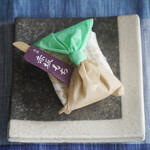
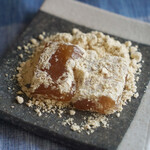
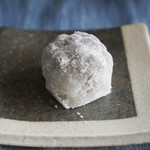
1sara
4.10
Located about a 5-minute walk from Akasaka Station, with no other customers on a weekday afternoon. They only offer takeout, but the store is spacious and they also sell taiyaki. Akasaka Mochi @ 237: A mochi with plenty of kinako and walnuts. The sweet mochi is soft and gooey, with a walnut accent. It is generously coated with kinako. The store provides instructions on how to eat it, advising to open the mochi on a small cloth and sprinkle it with kinako before eating. Mizumanju @ 270: A refreshing water-colored sweet on the day. The smooth sweet bean paste inside is lightly sweetened. The moist steamed bun is perfect for summer. Kansha no Kimochi: A mochi with plenty of brown sugar for a rich flavor. It is soft and delicious. The popular chilled mitarashi requires a reservation for purchase. Congratulations on being selected as one of the top 100 traditional Japanese sweets shops in Tokyo.
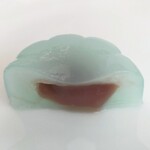
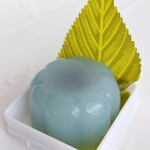
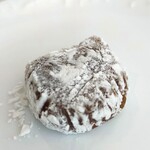
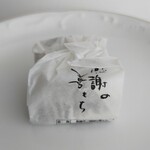
island2020
3.70
This is a well-established traditional Japanese confectionery shop founded during the Ansei era, with multiple stores in Akasaka. While their chilled mitarashi dango is famous, I stopped by to buy regular mitarashi dango. The main store is a bit of a walk from the station. The luxurious interior, adorned with marble, and the friendly and attentive staff made for a pleasant experience. The mitarashi dango called "Goma Meigetsu" here is topped with chestnuts and sprinkled with ground sesame seeds. It looks delicious and tastes just as sweet and delightful. However, I prefer a more rustic style of mitarashi dango, so I wish there were some with a slightly burnt exterior. I also purchased their specialty "Akasaka Mochi" with red beans and walnuts, looking forward to enjoying them at home.
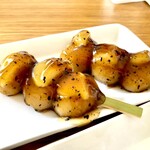

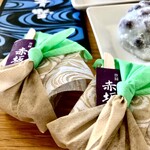
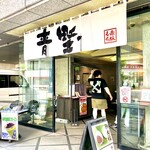
えこだねこ
3.80
Visited again in late August and couldn't resist the cool deliciousness, so I ended up ordering the same dish. This time, it was just as delicious and perfect for the scorching hot weather! The menu for this visit included chilled mitarashi (lunch) priced at 972 yen per person. This establishment is a long-standing traditional Japanese confectionery shop with a history of around 120 years. Their specialty dishes include Akasaka mochi and chilled mitarashi (available only in the summer). The chilled mitarashi I ordered this time cost 972 yen and requires a pre-order on their website due to limited quantities (up to 3 per person).
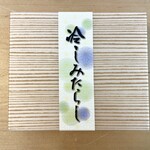

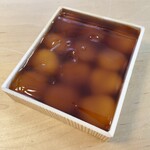
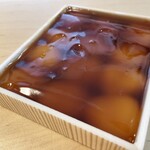
Email Login